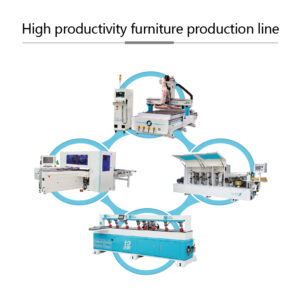Automation plays a significant role in modern panel furniture production lines by enhancing efficiency, accuracy, and productivity across various stages of the manufacturing process:
-
Precision Cutting and Shaping: Automated CNC machines precisely cut and shape wood panels or other materials according to exact specifications from CAD/CAM designs. This ensures accuracy and consistency in panel dimensions and shapes.
-
Edge Banding and Routing: Automated edge banding machines apply edge tapes or strips to panel edges and perform routing tasks with high precision, ensuring a uniform and professional finish.
-
Drilling and Boring Operations: Automated drilling and boring machines accurately create holes or pockets for fittings, hinges, or assembly points, maintaining consistency and minimizing manual errors.
-
Robotic Handling and Assembly: Robots or automated systems handle and assemble panel components, reducing manual labor, improving speed, and ensuring precise placement during assembly processes.
-
Finishing and Coating Applications: Automated systems apply paints, stains, or coatings uniformly across panels or furniture pieces, ensuring consistent finishes and reducing human error.
-
Material Handling and Transportation: Automated guided vehicles (AGVs) or conveyors transport materials or semi-finished products between workstations, optimizing material flow and reducing handling time.
-
Quality Control and Inspection: Automated vision systems or sensors inspect panels or finished products for defects, inconsistencies, or dimensional accuracy, ensuring quality standards are met.
-
Inventory and Stock Management: Automated systems track inventory levels, monitor usage, and trigger reordering of materials when stock reaches predefined levels, ensuring continuous supply without stockouts.
-
Workflow Optimization: Automation optimizes production workflows by minimizing idle time between processes, reducing setup times for different furniture designs, and improving overall efficiency.
-
Data Collection and Analysis: Automated systems collect real-time data on production metrics, allowing for analysis to identify bottlenecks, inefficiencies, or areas for improvement in the production line.
By integrating automation technologies into panel furniture production lines, manufacturers can achieve higher precision, increased productivity, reduced labor costs, improved quality control, and faster turnaround times. Automation not only streamlines processes but also allows for greater flexibility in manufacturing various furniture designs and customization options to meet evolving customer demands.
What are the key considerations in designing an efficient panel furniture production line layout?
Designing an efficient panel furniture production line layout involves several considerations to optimize workflow, productivity, and operational efficiency:
-
Workflow Analysis: Understanding the sequence of operations and workflow requirements is crucial. Analyze the steps involved in cutting, shaping, assembling, finishing, and packaging furniture pieces to create an efficient flow.
-
Space Utilization: Maximize the use of available space by organizing workstations, machinery, and material storage areas in a way that minimizes unnecessary movement and optimizes material flow.
-
Machinery Placement: Position machinery and equipment strategically to ensure a smooth and logical flow of materials between workstations, minimizing material handling and reducing idle time.
-
Workstation Ergonomics: Design workstations with ergonomic considerations to ensure comfort and safety for workers while optimizing their efficiency in performing tasks.
-
Material Handling and Logistics: Plan the layout to facilitate easy movement of materials between different production stages. Incorporate conveyors, automated guided vehicles (AGVs), or lifts to streamline material handling.
-
Flexibility for Changeovers: Design the layout to accommodate quick changeovers between different furniture designs or production runs, minimizing downtime and setup times.
-
Safety Measures: Ensure compliance with safety standards by incorporating proper spacing between machinery, providing clear pathways, and implementing safety features to protect workers.
-
Maintenance Accessibility: Design the layout to allow easy access for maintenance and repairs of machinery and equipment, reducing downtime for maintenance tasks.
-
Quality Control Points: Integrate quality control checkpoints strategically within the production line layout to ensure inspection and rectification of any issues at critical stages.
-
Employee Interaction and Collaboration: Foster communication and collaboration between workers by designing a layout that promotes teamwork and efficient communication between different departments or workstations.
-
Integration of Technology and Automation: Plan the layout to incorporate automation and technological advancements seamlessly, optimizing their integration into the production processes.
-
Waste Management and Recycling: Allocate space and resources for managing waste, recycling materials, or repurposing by-products generated during the manufacturing process.
-
Future Expansion and Scalability: Consider scalability in the layout design to accommodate future growth or changes in production volume, machinery upgrades, or process modifications.
A well-designed layout considers these factors to create a production line that operates smoothly, efficiently utilizes resources, minimizes waste, ensures worker safety, and delivers high-quality panel furniture products within desired timelines.







